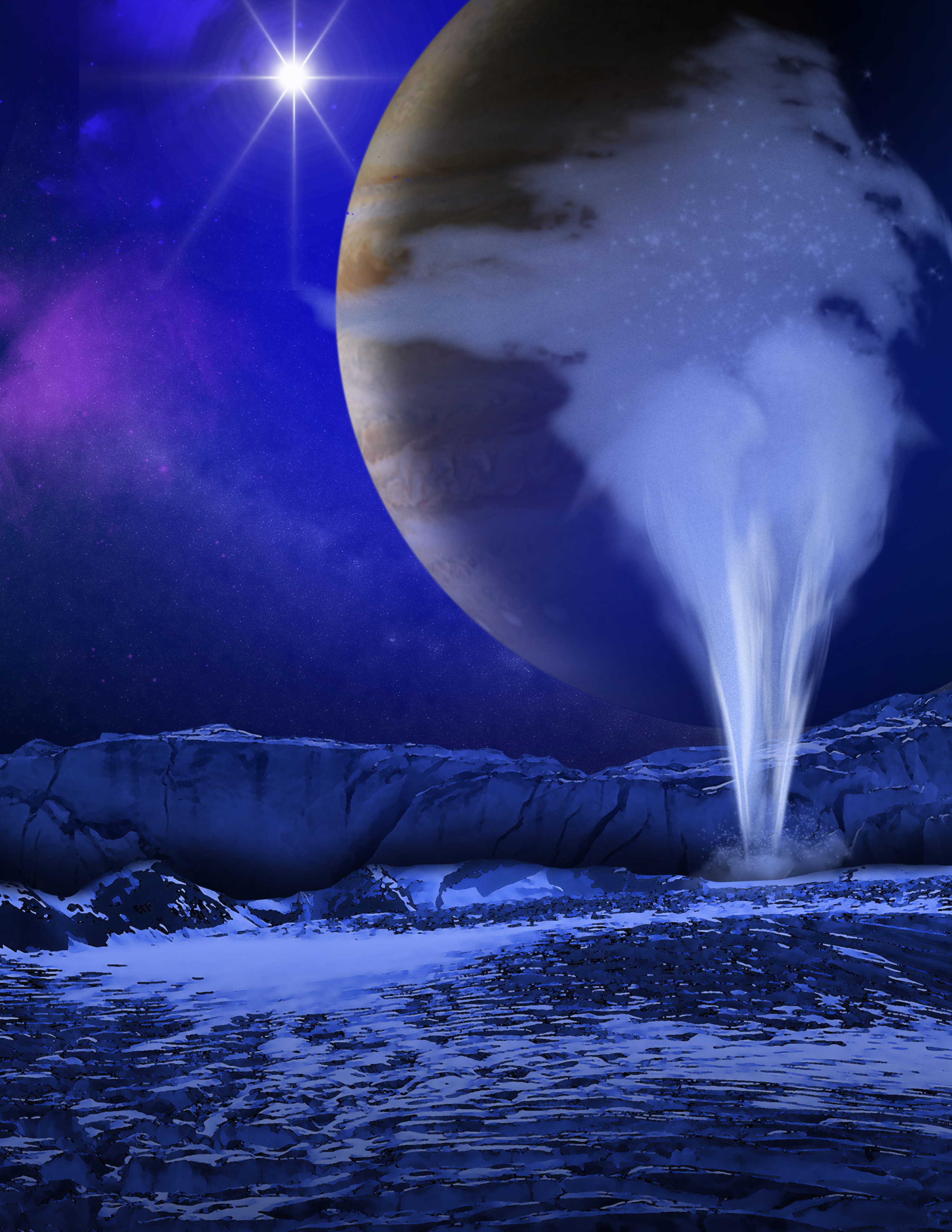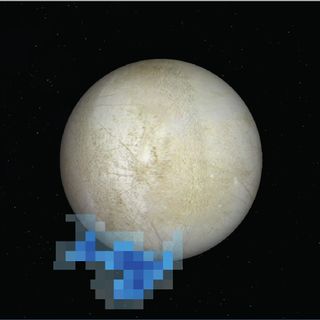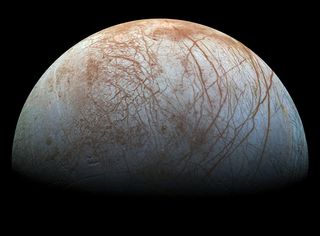Europa's Elusive Water Plume Paints Grim Picture For Life

A meteorite may have been responsible for a water plume briefly spotted above Europa two years ago, implying it takes a very rare event to breach the ice on the Jovian moon.
Astrobiologists worldwide received news in December 2013 that water vapor was detected in Hubble Space Telescope observations of Jupiter's moon Europa, which is considered one of the top potential locations in our solar system for life. Those results were published in the journal Science and led by Lorenz Roth, a planetary scientist at the Southwest Research Institute in Texas.
However, follow-up observations of Europa have found no plume emanating from the moon. A new paper based on observations made by NASA's Saturn-orbiting Cassini spacecraft reveals that Europa's atmosphere is 100 times less dense than claims in previous publications, and composed mainly of atomic rather than molecular oxygen. [Amazing Photos of Jupiter's Moon Europa]
Furthermore, the magnetosphere plasma, or superheated gas, at Europa’s orbit is very hot, with properties indicating that the plasma is mainly composed of ions, or charged particles, from the nearby moon Io.
Based on the plasma properties, the rate of injection of neutral gas from the surface of Europa is probably very low. This means the plasma in Europa's atmosphere has a low density, and a low escape rate into its magnetic field or magnetosphere.

No one knew what the plasma was made of before Cassini's measurements, which led some researchers previously to believe that the plasma came from Europa. Plasma can be comprised of different molecules, including hydrogen and oxygen, but Cassini's spectroscope was not designed to measure which species of molecules were present in the gas.
Because molecular hydrogen and atomic hydrogen were not found in Cassini's measurement of the plasma, this means that the plasma did not come from Europa as was previously suspected. The plasma that as detected was made of sulfur dioxide — a product of volcanoes on Io.
Get the Space.com Newsletter
Breaking space news, the latest updates on rocket launches, skywatching events and more!
“Our conclusion was that almost everything we were seeing was plasma from Io,” said Don Shemansky, chief scientist of the planetary and space science division of space weather company Space Environment Technologies (PSSD/SET).
However, a meteorite that briefly threw water aloft from Europa's surface cannot be ruled out, he said.
The results were published in The Astrophysical Journal.
Volcanic plasma
Study lead author Shemansky has spent most of his life exploring the solar system through the eyes of various NASA spacecraft, including Voyager and Cassini. He and his coauthors are team members of the Cassini UVIS experiment. The new data comes from a five-month Cassini flyby of Jupiter in 2000 and 2001.
Scientists already knew there was plasma in the vicinity of Europa based on data from Voyager's flyby, as well as the long-term Galileo mission, which explored Jupiter and its moons in the 1990s and 2000s. Those instruments, however, couldn't distinguish between different elements in the plasma and therefore could not determine the origin of the plasma. That's where Cassini was different.
Cassini confirmed a similar concentration of plasma that Voyager and Galileo saw. It further detected a mix of sulfur and oxygen ions that most likely come from Io. The moon's volcanoes spew these elements into its orbit, creating a plasma "torus" that Europa also passes through during its orbit around Jupiter.
"This points to very little output from Europa," Shemansky said.
If true, this would have grim implications for the prospect of life on Europa.
Europa would need to have fissures in its surface to allow for contact between its underground ocean and the combined effects of the magnetosphere and solar input on its surface. The energy input would include gravitational flexing by Jupiter in addition to the sun and magnetosphere. If Europa's plume is a rare event, this means there are likely few or no cracks in the surface. Europa might be a socked-in icy ball with a barren ocean below. [NASA Europa Mission May Search for Signs of Alien Life]
Shemansky emphasized that he has no reason to doubt the Roth et. al. observations. The spectroscopy they saw, replete with atomic oxygen, was in similar quantities that would be expected if water molecules were breaking apart. The water's hydrogen has enough energy to escape into the magnetosphere, while the oxygen remains closer to the surface.
"They were presenting for the first time what you would call direct evidence that we have water," Shemansky said.

But there were three issues with the theory, he said. While he says there is no reason to doubt the observations yet, the plume was the only direct indication of water ejection from the surface, the observation has not been repeated, and there was nothing unusual detected on the planet's surface at the time of the ejection.
Data collection problems
Io as a major source of mass and subsequent accumulation of energy in the magnetosphere is a conclusion drawn in a review a decade ago by Christopher Russell, a planetary scientist at the University of California, Los Angeles who examined the role of the volcanic moon's emissions in Jupiter's environment. The work was based in part on Voyager and Galileo observations.
"He paints a general picture that Io is the primary producer of mass that goes into the magnetosphere," Shemansky said.
Shemansky added that the radiation is easy to observe because there is so much energy associated with the Io torus. The energy comes from the rotation of Jupiter's magnetic field, which whips around quickly because the gas giant rotates with a 10-hour period.
Europa's plume reached a couple of hundred kilometers above the surface according to Roth et al, but did not have enough energy to escape into the magnetosphere, Shemansky added.
"The plume collapsed onto the moon's body, and that was the end."
More observations will be needed to confirm what happened during the plume's eruption, but Shemansky said one possibility is that a meteorite created a fissure in the surface that subsequently healed. There could, however, be more evidence lurking in archival data.
Because there is so much information flowing from each planetary mission, and inadequate resources to analyze it, data are often archived before researchers have had the chance to look at them. It took Shemansky's team nearly 15 years to look back at Europa's plasma environment based on the Cassini flyby, and he said there are reams of data available from Cassini's orbits around Saturn that may not be looked at for years or decades to come, unless more funding appears.
This story was provided by Astrobiology Magazine, a web-based publication sponsored by the NASA astrobiology program. Follow Space.com @Spacedotcom, Facebook and Google+.
Join our Space Forums to keep talking space on the latest missions, night sky and more! And if you have a news tip, correction or comment, let us know at: community@space.com.

Elizabeth Howell (she/her), Ph.D., is a staff writer in the spaceflight channel since 2022 covering diversity, education and gaming as well. She was contributing writer for Space.com for 10 years before joining full-time. Elizabeth's reporting includes multiple exclusives with the White House and Office of the Vice-President of the United States, an exclusive conversation with aspiring space tourist (and NSYNC bassist) Lance Bass, speaking several times with the International Space Station, witnessing five human spaceflight launches on two continents, flying parabolic, working inside a spacesuit, and participating in a simulated Mars mission. Her latest book, "Why Am I Taller?", is co-written with astronaut Dave Williams. Elizabeth holds a Ph.D. and M.Sc. in Space Studies from the University of North Dakota, a Bachelor of Journalism from Canada's Carleton University and a Bachelor of History from Canada's Athabasca University. Elizabeth is also a post-secondary instructor in communications and science at several institutions since 2015; her experience includes developing and teaching an astronomy course at Canada's Algonquin College (with Indigenous content as well) to more than 1,000 students since 2020. Elizabeth first got interested in space after watching the movie Apollo 13 in 1996, and still wants to be an astronaut someday. Mastodon: https://qoto.org/@howellspace
